2009 Mariner Hybrid – Click above for high-res image gallery
Ford took pride in being the first automaker on the planet to offer a hybrid utility vehicle when it introduced the first battery-assisted Ford Escape in mid-2004. The Escape hybrid has had mixed success over the past few years, but with gas prices hitting $4 per gallon, the Blue Oval is selling every unit it can produce. For the 2008 model year, one in eight Escape sales are hybrids, which is impressive when you consider that it averages $30,000 per vehicle. In 2006, the Escape was joined by the lower volume Mariner Hybrid, giving Ford two entries in the hybrid soft-roader market, and a green model to sell at Lincoln-Mercury dealerships.
The Escape got a thorough makeover on the outside for 2008, but most of the mechanicals remain a carryover from the previous generation. For 2009, Ford finished the job on the Escape and its sheet metal sibling from Mercury and the hybrid models followed suit. The changes include a new engine that provides more power and improved efficiency, some cosmetic tweaks, and several technological upgrades. Ford is betting that the changes will improve their footing in the green scene, so we took a loaded Mercury Mariner hybrid into the Autoblog Garage to see if the fuel-sipping CUV could win us over.
All photos Copyright ©2008 Chris Shunk / Weblogs, Inc.
Our loaded Light Ice Blue tester came equipped with leather seats, moon roof, Travel Link navigation, and a rearview camera, bring the grand total of the luxo-hybrid to a husky $33,000. But according to Mercury, buyers will be able to achieve over 30 mpg in mixed driving without having to sacrifice ride quality, refinement or aesthetics, something that's sure to please both soccer moms and the Sierra Club.
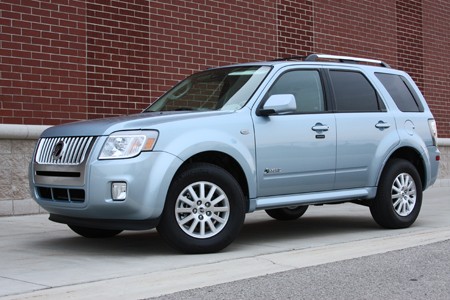
The Mariner Hybrid's new powertrain is a 2.5L four-cylinder running on the Atkinson cycle, which is mated to the same CVT as the last-generation model. The new mill is essentially a bored-out version of the outgoing 2.3L, though Ford added variable intake timing to improve power and refinement. The new engine is much smoother and more powerful than the previous powerplant, though fuel economy doesn't suffer as a result. The Mariner Hybrid keeps the holdover 330-volt Nickel Metal Hydride battery pack, though the energy-capturing electric brake system is new, recharging the battery pack, and unlike the outgoing model, it allows for stability and traction control.
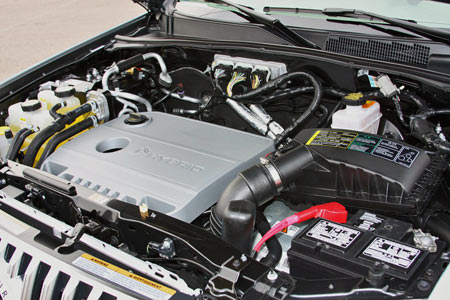
The tinkering didn't end with the powertrain, either. Ford also added high-strength steel to the A-pillar, frame rails and cross members, which stiffens the Mariner's structure while providing a more comfortable ride around town. Several software enhancements were added to better-optimize efficiency and to make the shift from engine-power to battery-power and back smoother than before.
All those improvements translated well out on Michigan roads, as the 2009 Mariner Hybrid was much more refined than its 2008 predecessor. The new Mariner Hybrid is quieter, the engine turn-off isn't noticable and drivers can now go up to 40 mph without having to revert to petrol-power. In heavy traffic, we were so excited that we weren't using any fuel that we hardly noticed that our day was wasting away in a sea of metal and CO2, and it's nice to go through a fast food drive-through without contributing to global warming. If hybrids could only help us burn calories, we'd all want one.
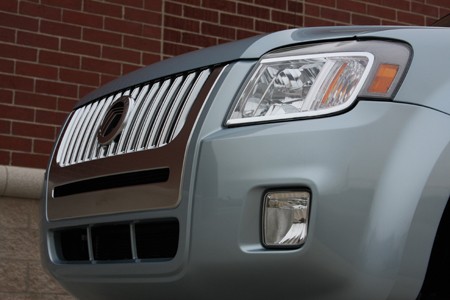
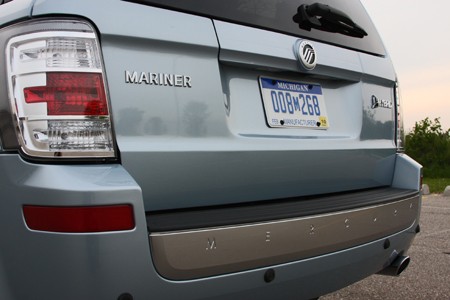
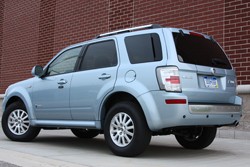
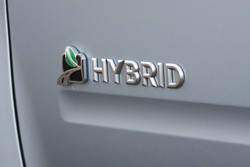
Whether the engine was on or off, we were impressed with the newly solidified drive characteristics. While the 2008 model looked the part of an all-new CUV, it sometimes felt floaty and cheap on the road, but the 2009 model has better balance and all-around improved composure on the road. The 41 psi low rolling resistance tires didn't feel harsh on bumpy roads, which is a notable improvement over the jarring ride of its battery-assisted predecessor.
While our one week in hybrid land was generally problem free, we did experience about a day and a half when the battery didn't take over for us at all. While it pitched in with assistance at all speeds, it didn't shutter the engine at stops, and it didn't take over at low speeds. The battery never went below 50-percet utilization at any point, but after about 75 miles, everything went back to normal.
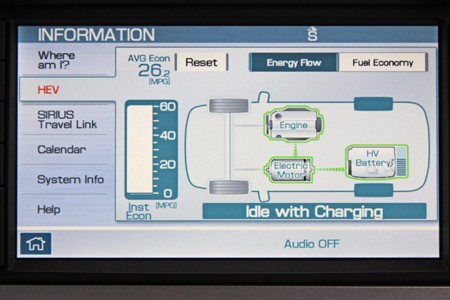
Over the course of our drive, we managed a combined 32 mpg in mixed driving (photo above was taken before we reset fuel economy info) which includes roughly a 50/50 mix of highway and city driving on our daily commute. While that tally is far shy of the 43 mpg we achieved with the Prius last year, it's far better than what we've gotten with most non-hybrid compacts we've sampled in the past, and it was substantially better than the 26 mpg we got with the Saturn Vue hybrid. Even when we did have to fuel up, the cap-less fuel system made the task a little easier.
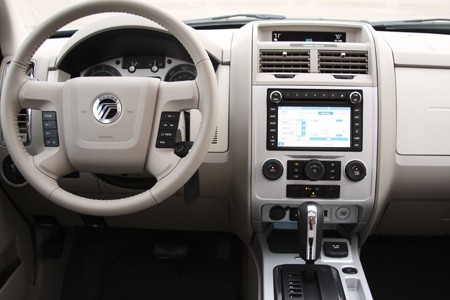
On the inside, the Mariner had plenty of interesting features that should help make the daily drive more palatable. To begin with, Ford's new Travel Link navigation system is incredible. You can check sports scores, weather, gas station information, and movie theater times with minimum navigation. The GPS system works well for directions and maps, and the system comes with a ten-gigabyte hard drive for storing your favorite music. Fuel-conscious drivers can also keep tabs on fuel economy and battery charge by clicking on the info button. We spent most of our week staring at the efficiency display (when it was safe), which made us keenly aware of what our right foot was doing, causing fuel economy improved in turn.
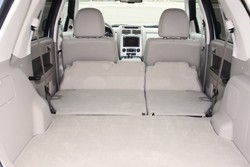
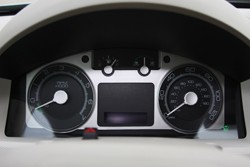
Ford also does a solid job of keeping the driver comfortable with leather seating surfaces with good lateral support, a thick, comfortable leather-wrapped steering wheel, and a cushy resting place for our right arm. The gauge cluster is well lit and easy to read, and there is a meter on the RPM gauge to show when you're driving under battery power.
Our tester also came with a large moon roof that disappointingly didn't open up very far. The size of the opening doesn't justify the added cost and weight to the vehicle, and it doesn't bring in much fresh air. Storage space behind the second row is less than spectacular, and folding the back row completely flat into the floor requires that removal of the headrests. That's problematic because of the amount of effort it takes to get them off, but more importantly, there are a lot of people that will remove the head rests and forget to replace them when they put the seats back into the upright position.
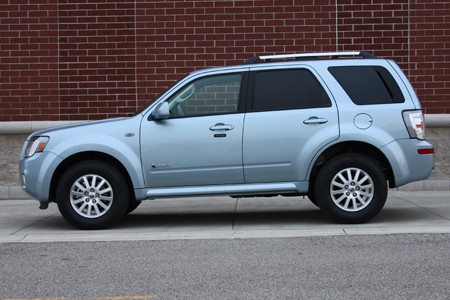
After one week in the Autoblog Garage, we're confident that the 2009 Mercury Mariner Hybrid is a more competent, more refined, and more powerful vehicle than the model it replaced. It easily achieves the fuel economy most of us would kill for, and it looks good doing it. The only thing that would give many of us pause is the $33,000 price tag, but with gas prices on a seemingly unstoppable upwards trajectory, 32 mpg accompanied by plenty of amenities doesn't seem like a bad deal. And in the world of econ-conscious commuters, you could do a lot worse than the Mariner Hybrid.
All photos Copyright ©2008 Chris Shunk / Weblogs, Inc.
The video meant to be presented here is no longer available. Sorry for the inconvenience.
Autoblog review of the 2009 Mercury Mariner Hybrid


Sign in to post
Please sign in to leave a comment.
Continue